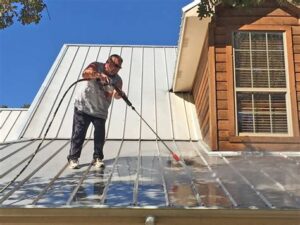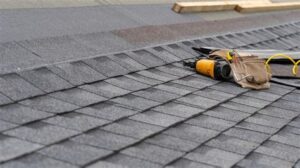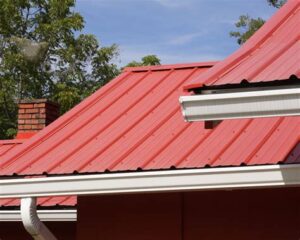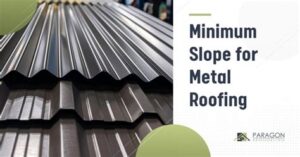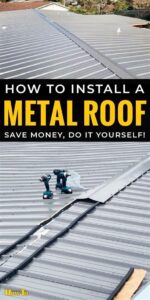Are you considering a roof upgrade but unsure of your options? Look no further! This comprehensive guide is here to illuminate the world of metal roofing, detailing everything you need to know about its costs and benefits. From an in-depth breakdown of metal roofing prices to understanding the factors that influence them, we’ve got you covered. Discover why metal roofing is a worthwhile investment, offering not only aesthetic appeal but also lasting durability and energy efficiency. We’ll also walk you through selecting the right material for your home, ensuring you make an informed decision. Plus, learn about the significant long-term savings that come with choosing metal roofing over traditional options. Read on to explore this invaluable resource that can transform your home and financial future!
Understanding Metal Roofing Costs: A Complete Breakdown
When considering a new roofing system, it’s essential to grasp the various components that contribute to the total cost of metal roofing. This understanding will help homeowners make informed decisions and budget effectively for their projects.
The cost of metal roofing can vary widely based on several factors, which can be categorized into materials, labor, and additional considerations. Here’s a detailed breakdown:
1. Material Costs
- Type of Metal: Different metals come with varying price tags. Steel is generally the most affordable option, while aluminum and copper can be more expensive.
- Coatings and Finishes: Additional protective coatings or aesthetic finishes can increase your costs, but they may add to the longevity and beauty of your roof.
2. Installation Costs
- Labor Rates: Costs associated with hiring professional roofers can fluctuate based on regional labor rates and the complexity of your roof
- Roof Structure: A roof with multiple angles, steep slopes, or existing structural issues may require more labor, inflating the overall cost.
3. Additional Considerations
- Underlayment and Insulation: These materials are essential in ensuring your roofing performs well but add to your cost.
- Disposal Fees: If you are replacing an existing roof, consider the costs associated with removing and disposing of old materials.
- Warranty Options: Investing in a longer warranty can save money in the long run, though it may increase upfront costs.
Understanding the full scope of a complete price breakdown for metal roofing is imperative for homeowners. Doing your due diligence and comparing various options can ensure a favorable balance between quality and cost, ultimately leading to a wise investment in your home’s future.
Benefits of Metal Roofing: Why It’s Worth the Investment
Investing in metal roofing comes with a multitude of advantages that make it an appealing choice for homeowners and commercial property owners alike. Here are some notable benefits:
- Durability: Metal roofs are exceptionally durable and can last 40-70 years, outlasting traditional asphalt shingles by decades.
- Energy Efficiency: Metal roofing reflects solar radiant heat, which can reduce cooling costs by 10-25%. This contributes to lower energy bills and a smaller carbon footprint.
- Low Maintenance: Unlike other roofing materials, metal roofs require minimal maintenance, saving you time and money in the long run.
- Fire Resistance: Metal roofs are non-combustible, giving them a Class A fire rating, which can provide peace of mind and potentially lower insurance premiums.
- Aesthetic Appeal: Available in a variety of styles and colors, metal roofing can enhance the overall appearance of your property, making it an attractive option.
- Eco-Friendly: Many metal roofs are made from recycled materials and are 100% recyclable at the end of their life, making them a sustainable choice.
When considering the A Complete investment in metal roofing, homeowners can also benefit from increased property value and potential tax credits or rebates for energy-efficient upgrades. Overall, the initial investment in metal roofing often pays off significantly over time, both in savings and in the long-term value it offers.
| Benefit | Details |
|---|---|
| Durability | Lasts 40-70 years |
| Energy Efficiency | Reduces cooling costs by 10-25% |
| Low Maintenance | Minimal upkeep required |
| Fire Resistance | Class A fire rating |
| Aesthetic Appeal | Available in various styles and colors |
| Eco-Friendly | Made from recycled materials and recyclable |
With these benefits in mind, it’s clear that metal roofing is not just a practical choice but also an investment that adds value, efficiency, and peace of mind to any property.
Factors Affecting Metal Roofing Prices and Their Impact
Metal roofing prices can vary significantly based on several key factors. Understanding these factors can help homeowners make informed decisions when considering a metal roofing installation.
Here are the main factors that can affect the price of metal roofing:
- Material Type: Different types of metals, such as aluminum, steel, and copper, come with varying costs. Steel roofs are often the most affordable, while copper is on the higher end of the price spectrum.
- Gauge Thickness: The thickness of the metal used in roofing, measured in gauge, can impact pricing. Thicker gauges tend to cost more but also offer better durability and lifespan.
- Style and Design: The architectural style you choose, whether it’s standing seam, corrugated panels, or shingles, can greatly affect the overall cost. More intricate designs may require additional labor and materials.
- Installation Complexity: Roofing systems involving multiple slopes or complex layouts often lead to higher labor costs. If the installation requires specialized skills or equipment, expect to pay more.
- Labor Costs: Labor costs can vary based on location and contractor experience. Hiring skilled professionals may incur higher expenses, but it can lead to better workmanship and fewer future complications.
- Geographical Location: The overall cost can differ depending on your region. Areas with a higher cost of living may see increased prices for both materials and labor.
- Roof Size: The larger the roof, the more materials required, which directly affects the cost. However, buying in bulk may lead to some cost savings per square foot.
- Project Timing: Seasonal demands can influence pricing. Contractors may charge more during peak seasons when they are in high demand, while offers and discounts may occur during off-peak times.
- Add-Ons and Finishing Touches: Additional items such as insulation, rain gutters, and trim can increase the overall price. While these are optional, they can enhance performance and aesthetics.
Understanding these factors is essential for anyone considering metal roofing. It allows you to budget effectively and select the right materials and services for your project. By evaluating how these elements intertwine, you can achieve a balance between cost and quality, making your investment truly worthwhile.
A Complete Guide to Choosing the Right Metal Roofing Material
When it comes to metal roofing, selecting the right material is crucial for ensuring durability, aesthetic appeal, and overall value. Here’s a comprehensive look at the various types of metal roofing materials available and how to choose the best one for your needs.
1. Steel Roofing
Steel is one of the most commonly used metals for roofing due to its durability and affordability. It comes in various styles, including galvanized and Galvalume, both offering excellent protection against corrosion. Steel roofing typically requires periodic maintenance and repainting to maintain its integrity.
2. Aluminum Roofing
Aluminum is lightweight, rust-resistant, and ideal for coastal areas where salt exposure can damage other metals. It is more expensive than steel but offers superior longevity and does not require as much upkeep. Aluminum is also available in various finishes and colors, enhancing curb appeal.
3. Copper Roofing
Copper offers a unique aesthetic that develops a beautiful patina over time. While it is one of the priciest options, its lifespan is significant, often exceeding 50 years. Copper is ideal for homeowners looking for a distinctive look and exceptional longevity but should be considered carefully due to the initial investment.
4. Zinc Roofing
Zinc is another premium metal roofing material known for its longevity and self-healing properties. It requires minimal maintenance and can last over 100 years. Zinc roofs are environmentally friendly, as they can be recycled, making them an excellent choice for eco-conscious homeowners.
5. Metal Roof Panels vs. Tiles
Metal roof panels are typically faster to install and more economical than metal tiles. However, metal tiles offer a greater aesthetic appeal and can resemble traditional roofing materials like clay or slate. Consider the overall architectural style of your home when making this decision.
6. Gauge Considerations
The gauge of the metal significantly influences the durability and cost of the roofing material. Lower gauge numbers indicate thicker metal, which withstands harsh weather conditions better. For residential projects, a gauge between 24 and 26 is typically recommended for optimal strength and cost-effectiveness.
7. Finish and Coating Options
Different finishes, such as Kynar or polyester coatings, can enhance your metal roof’s lifespan and resistance to fading. Research your options for protective coatings to choose one that will best suit your climate and aesthetic preferences.
Choosing the right metal roofing material involves weighing factors such as longevity, maintenance requirements, budget, and visual appeal. Consider consulting with a professional to discuss your specific needs and make an informed choice that will enhance the comfort and value of your home.
Long-Term Savings: The Financial Advantages of Metal Roofing
When considering A Complete overview of roofing options, metal roofing stands out not only for its durability and aesthetic appeal but also for significant long-term savings. Understanding the financial advantages of investing in metal roofing is crucial for homeowners looking to maximize their investment.
Firstly, metal roofing typically boasts a lifespan of 40 to 70 years, significantly surpassing traditional shingles, which may need replacement every 15 to 20 years. This longevity means fewer replacement costs over time, making it a wise investment.
Additionally, metal roofs are highly resistant to weather-related damages, such as wind, fire, and hail. This resilience translates into lower repair and maintenance costs, further enhancing the financial benefits of metal roofing. Homeowners can have peace of mind knowing that their roofs will withstand the test of time and nature.
Moreover, many homeowners are surprised to learn that metal roofing can lead to decreased energy costs. Metal roofs reflect solar radiant heat, which can reduce cooling costs by 10-25%. This energy efficiency not only helps save money on monthly utility bills but also contributes to a greener environment.
It’s worth noting that metal roofs can significantly increase a property’s resale value. A study by the Metal Roofing Alliance indicates that homes with metal roofing can recoup up to 85% of their installation costs upon sale, making it a financially sound investment that pays off in the long run.
Investing in metal roofing presents a multitude of financial advantages. With its longevity, low maintenance needs, energy efficiency, and potential for increased home value, choosing metal roofing can be one of the best decisions for homeowners looking to secure their financial future.
Frequently Asked Questions
What factors influence the cost of metal roofing?
The cost of metal roofing can be influenced by materials used, roof pitch, labor costs, and the complexity of the roof design.
How does metal roofing compare to traditional roofing materials?
Metal roofing typically has a longer lifespan and better durability compared to traditional roofing materials, making it more cost-effective in the long term.
What are the benefits of installing metal roofing?
Benefits of metal roofing include longevity, energy efficiency, low maintenance, fire resistance, and a wide variety of styles and colors.
Is metal roofing energy efficient?
Yes, metal roofing can be energy efficient; its reflective properties help reduce cooling costs during hot weather.
What is the average lifespan of metal roofing?
Metal roofing can last anywhere from 40 to 70 years, depending on the material and maintenance.
Can I install metal roofing over my existing roof?
In many cases, metal roofing can be installed over existing roofing materials, which can lower installation costs and reduce waste.
What maintenance is required for metal roofing?
Metal roofing requires minimal maintenance, typically involving occasional inspections, cleaning, and ensuring that fasteners and flashing are secure.
